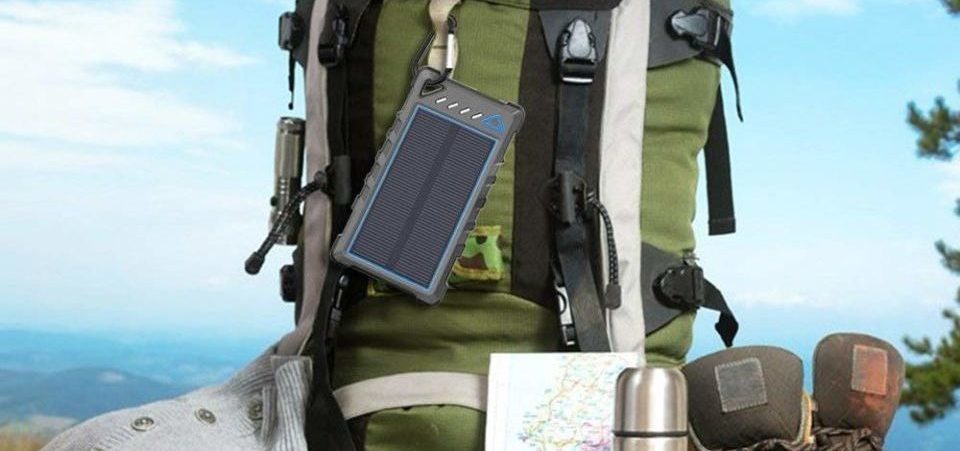5 Tips for Choosing a Solar Power Bank

When going to purchase a portable solar power bank, there are many questions that may arise as you check on the products. If you have any doubts about which factors you should take into account when choosing one of these products, then you will find these tips very useful.
Check the Battery Capacity
Maybe the most important factor of any solar power bank is the capacity that the lithium battery has.
The battery capacity represents the amount of energy that can be stored inside the backup battery and is generally expressed using mAh or Wh units.
A portable solar power bank could have as low as 2000mAh of battery capacity which could be enough to charge your device (probably a single charge of a cellphone), this can be classified as a small solar power bank.
On the other hand, the device could also have as much energy capacity as 50000mAh which could be enough to charge tablets, charge your smartphone or laptop several times. This can be classified as a large solar power bank.
As you can presume, cost and also weight vary according to these facts. Therefore, you must select the solar power bank taking into account the purpose for which you are going to use it.
If you are going to use this external battery for your daily life on the city or town and you simply want to have a backup battery in case you RUN OUT OF POWER, then you will probably only need a simple 2000mAh portable solar power bank.
However, if you are looking to have a backup battery that lasts for days while being off-grid on a camping trip or when going hiking, then you will need a larger solar power bank with capacities between 10000-50000mAh depending on the number of days.
Also, remember that a large capacity always demands more time to charge completely.
Think About Portability
The main idea of a portable solar power bank is to provide a reliable power source while being off-grid, but without representing any important sacrifice in the process of carrying the device from one place to another.
Top portable solar chargers should take this fact into account and offer the small, lightweight, and easy to carry solution.
If you are evaluating several options, then consider which ones are foldable, which power bank includes a STEEL LOOP to hang it on the backpack WHILE YOU WALK (it’s crucial to take advantage of the time to charge the battery while you walk), and which one is smaller.
Another important fact must be taken into account in portability is related to durability. Since it will probably be performing in outdoor activities, it is very important that the battery and the solar panel have a protective cover against water, dust, and shocks
Verify Solar Panel SPECS
The main purpose of choosing a solar power bank battery charger is that it charges the battery using the Sun’s energy without depending merely on power from the grid.
Since the main source of power here is the solar panel, it is crucial to examine the quality of the solar cells.
Efficiency is the most important factor here. If efficiency is low, the device will need larger portable solar panels and much more time to get the battery fully charged, which impacts portability.
No other brand in the world offers a better efficiency for solar cells than SunPower. Therefore, if you have to choose between a solar charger power bank with SunPower solar panels and another product that is less expensive but that uses unknown solar panels, the best choice is to go with the SunPower one.
How Many Available USB charging Ports Does the Solar Power Bank Have?
One of the greatest features a power bank can have is to be able to charge multiple devices at the same time.
Most power banks will have dual USB ports. However, you will find some that may have three USB ports included of different types and for different devices.
This is very useful as it means that within the same time range you could charge your laptop, your smartphone, and your iPad. If the solar power bank you are evaluating, only has a single USB port, then it is not worth it.
Additional Features
As usual, the extra feature that the manufacturer wants to add to the power bank always balances the equation.
Features such as LED indicators, LED LIGHT MODES OF OPERATION, steel loops for hanging, aesthetic design, Quick Charge 3.0 USB ports, and included accessories such as a USB cable or an adapter are always factors that could help you take a decision.
How Much Should I Expect to Pay for a Top Solar Power Bank?

As we mentioned before, the price will be directly related to the battery capacity, but also to the solar panel technology and the brand.
A good quality solar power bank should never cost more than 60 USD.
Price ranges for power banks with capacities between 10000mAh and 20000mAh should be located between 20USD and 30 USD. Over 20000mAh you could expect prices to rise to 40-50USD.
What Devices Can I Charge?
In most cases, solar power banks are used to charge the following electronic devices:
- Smartphones
- Laptops
- Tablets
- iPhones
- iPads
- GoPro Camera
- GPS
- Portable speakers
- Portable radios
The possibility to charge an electronic device or not will depend on the USB port type of the solar power bank. Most products have a universal USB output, but some have micro-USB or type C charging ports. In any case, you can always look for an adapter to connect your phone.
What Phones Are Compatible?
Most cell phones are compatible with solar power banks because most cell phones can get connected to a universal USB port. Therefore, you can use a power bank to charge smartphones such as:
- iPhone X, 8 7, 6.
- Samsung Galaxy S8
- Samsung S8 Plus
- LG Stylus 2
- Windows Phones
- Sony Xperia Z2
- Nokia 1 Plus
- And many more
Every smartphone has a lithium-ion battery that you can check on the specs of your phone. All you need to do to verify whether or not your solar power bank is suitable to charge your phone. First, check the battery capacity of the smartphone in mAh.
Then, divide the battery capacity of the power bank when its fully charged by the energy needed by the smartphone. You will then will find the number of times that the power bank can charge your phone.
Also, take into account the type of charging ports that the smartphone needs and see if the USB solar power bank includes it. If not, simply purchase an additional adapter.
Another fact that you could take into account, which is not limiting but worth knowing, are the AMPERES that your cell phone needs to charge.
Universal USB outputs have a 2A output, however, you may find some with 2.1 A, 2.4A or even 3A. This will influence the charging speed of the mobile phones, but could also impact the performance of the battery since cell phones are designed with a specific NOMINAL electric current.
Check the battery specs of your smartphone to see if the nominal electric current demanded is lower or higher than the one of the USB port, if it is lower, then there is no problem, the power bank will only provide the current that the phone needs. But, if it’s higher, consider looking for another power bank.
Roughly How Long Does a Full Charge Last?

The answer to this question varies from user to user, from power bank to power bank, and from smartphone to smartphone.
Basically, the battery capacity determines how long the fully charged power bank will last.
As an average range to take into account, a fully-charged 24000mAh solar power bank should be able to charge an iPhone or a Samsung phone at least 8-10 times. Considering that the battery of a smartphone should last at least 1 day under continuous use, then we can say that the solar power bank should last around 1 week.
However, if you use the external battery to charge multiple devices, then the charger won’t last as long. Consider if you are looking for a solar power bank for laptop or if what you want is a cell phone solar power bank. This will influence the decision of the battery capacity.
Roughly How Long Does a Full Charge Take?
As with the previous statement, the battery capacity determines the charging capability.
Solar power is a source of energy that varies according to climatological conditions. Therefore, establishing charging times is not an easy task.
However, based on recommendations from manufacturers, we can establish some charging range.
For instance, for a 20000mAh power bank, requires between 60-70 hours to charge (around 3 days) only using solar energy as a primary resource.
Another way to estimate this is to apply the following expression
Time to charge= (Solar power bank capacity) / (solar panel power)
If we are dealing with a solar power bank of nearly 10,000mAh and we have a 2W panel, then:

Remember that 5V is related to the voltage at which the battery gets charged and 0.8 is a factor referred to losses in solar energy into electrical conversion.
If you have access to a POWER OUTLET, use it. You could end up reducing charging times by 5-6 hours. Before taking any trip, fully charge your solar power bank by plugging it into an outlet, and use solar energy as a CONSTANT RECHARGE SOURCE while you are outdoors.
posted from Bloggeroid
No comments:
Post a Comment